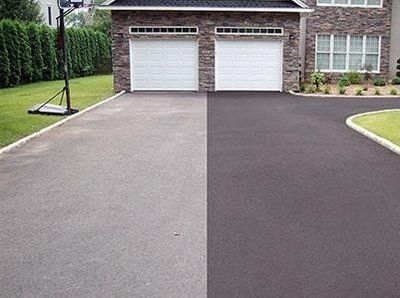Hot Mix Asphalt: A Lasting Service for Sidewalk
Hot Mix Asphalt (HMA) has actually arised as a leading lasting choice for sidewalk solutions, using a myriad of environmental benefits and cutting-edge modern technologies. As the need for green building practices grows, exploring the nuances of HMA's sustainability can provide beneficial insights into the future of sidewalk services.
Ecological Benefits of Hot Mix Asphalt

In Addition, Warm Mix Asphalt assists to mitigate city warm island results. Its dark color soaks up sunlight, lowering the amount of warmth reflected back into the environment contrasted to lighter-colored pavements. This can lower ambient temperature levels in urban locations, decreasing the need for air conditioning and ultimately lowering energy intake.
Additionally, Hot Mix Asphalt adds to boosted stormwater management. Its porous nature enables water to reenergize and infiltrate the pavement groundwater products, minimizing overflow and the danger of flooding. These ecological advantages make Hot Mix Asphalt a sustainable choice for leading roadways and freeways.
Power Effectiveness in HMA Production
Is power effectiveness an important factor in the manufacturing of Hot Mix Asphalt (HMA)? Energy plays a significant duty in the manufacturing of HMA, impacting both cost and environmental sustainability. One crucial facet of energy efficiency in HMA production is the usage of warm mix asphalt (WMA) modern technologies.
Furthermore, improvements in plant innovations have led to even more energy-efficient HMA production processes. By maximizing power usage in HMA manufacturing, the sector can reduce its carbon impact while maintaining high-quality pavement products.
Recyclability of Hot Mix Asphalt
The recyclability of Warm Mix Asphalt (HMA) is a crucial aspect of its sustainability and long-term ecological influence. HMA is just one of one of the most recycled materials in the USA, with over 100 million bunches of redeemed asphalt sidewalk (RAP) being reused annually in new pavement building and construction. Reusing HMA supplies several environmental benefits, such as minimizing the demand for virgin products, reducing energy intake during production, and lowering the quantity of waste sent to landfills.
The procedure of recycling HMA involves crushing the existing sidewalk, crushing it right into smaller items, and blending it with brand-new accumulation and asphalt binder to create a recycled mix. This recycled mix can typically execute in addition to and even better than conventional HMA, while requiring less basic materials and creating reduced greenhouse gas discharges. By incorporating RAP into brand-new pavement tasks, roadway agencies can conserve all-natural sources, lower expenses, and reduce the environmental footprint of roadway building and construction and maintenance activities. On the whole, the recyclability of HMA plays a check that considerable role in promoting lasting methods within the sidewalk industry.

Long-Term Efficiency of HMA
Asphalt sidewalks show toughness and strength over an extensive duration, mirroring the long-lasting efficiency of Warm Mix Asphalt (HMA) Furthermore, advancements in HMA modern technology, such as the usage of polymer-modified binders and warm mix asphalt, have actually better enhanced the longevity and longevity of HMA sidewalks. By focusing on top Read More Here quality construction and maintenance methods, HMA continues to confirm itself as a sustainable and economical remedy for long-lasting pavement infrastructure.

HMA: Longevity and Sustainability
Showing both resilience and sustainability, Warm Mix Asphalt (HMA) has come to be a keystone in the building of resilient sidewalk facilities - angled parking. HMA's sturdiness stems from its capacity to stand up to heavy lots, extreme weather, and high traffic volumes, making it a reliable selection for roads, highways, and flight terminal paths. The structure of HMA, which typically company website consists of aggregates, binder, and filler, plays a critical duty in boosting its durability and resistance to wear and tear
Moreover, HMA's sustainability hinges on its recyclability and energy-efficient manufacturing process. The ability to reuse recovered asphalt sidewalk (RAP) in new HMA mixes decreases the need for virgin materials and reduces the ecological influence of sidewalk building and construction and upkeep. Furthermore, the power efficiency of generating HMA depends on its reduced blending temperature levels compared to various other sidewalk materials, causing decreased power intake and greenhouse gas exhausts.
Conclusion
In verdict, warm mix asphalt (HMA) provides a sustainable service for pavement with its eco pleasant attributes. HMA's recyclability, power effectiveness in manufacturing, and long-lasting resilience make it an eco-friendly option for road construction.
HMA is one of the most recycled products in the United States, with over 100 million lots of reclaimed asphalt sidewalk (RAP) being recycled annually in brand-new sidewalk building.The process of recycling HMA includes crushing the existing pavement, squashing it right into smaller items, and mixing it with new accumulation and asphalt binder to develop a recycled mix.Asphalt sidewalks show sturdiness and strength over an extensive period, reflecting the long-term efficiency of Hot Mix Asphalt (HMA) Furthermore, innovations in HMA technology, such as the use of polymer-modified binders and cozy mix asphalt, have additionally improved the sturdiness and long life of HMA pavements. The capability to recycle redeemed asphalt pavement (RAP) in brand-new HMA combinations minimizes the demand for virgin products and lessens the environmental impact of pavement building and maintenance.